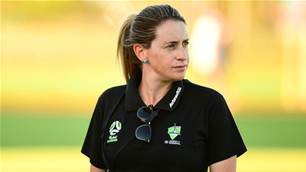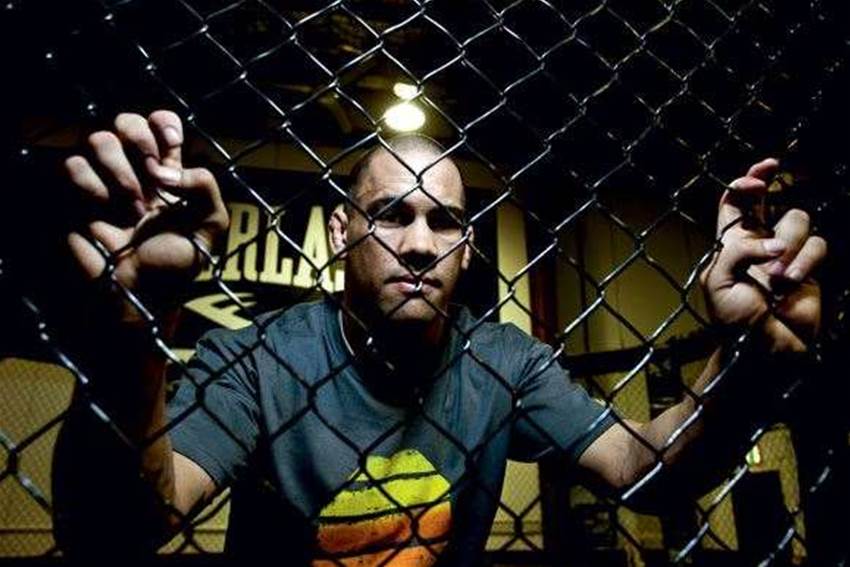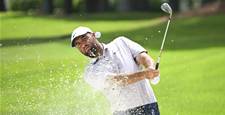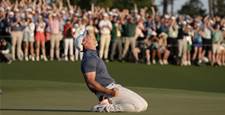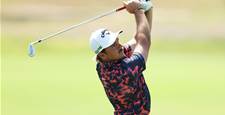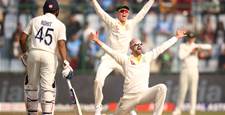His 19 professional Mixed Martial Arts (MMA) fights have yielded 14 victories, seven of them by fistic knockout.
His 19 professional Mixed Martial Arts (MMA) fights have yielded 14 victories, seven of them by fistic knockout...
With his shaven head, his mountainous neck and his inked arms, James Te Huna is the standover man from central casting. Put him in the octagon and he plays to character. He lists his most potent weapons as his takedowns and his ground-and-pound. For those unfamiliar with UFC cant, this means he likes dumping fighters on their backs, pinning their arms, then shouldering punches onto their unprotected faces. Brutal but effective. His 19 professional Mixed Martial Arts (MMA) fights have yielded 14 victories, seven of them by fistic knockout.
 James Te Huna Boxing Ring Images: Warren Clarke
James Te Huna Boxing Ring Images: Warren ClarkeOut of the octagon, however, Te Huna is a different man. Born and raised across the ditch, he carries those typical Kiwi traits: he’s got a ready laugh and he loves a chat. He moved to Australia when he was 16 and promptly earned a crust laying bricks. He figured there had to be an easier way. So he turned his hand to professional fighting. Sure, it’s a tad more dangerous but the pay packets are a little thicker, particularly now he’s broken into the rarefied atmosphere of the UFC
Early days
“As young kids, me and my brother loved Bruce Lee movies. So I started going to a karate gym when I was eight, then I started going to a boxing gym when I was 13. I was the smallest and skinniest kid at my school in Darfield – I wanted to look intimidating, wanted kids to stop picking on me… So I started boxing, nothing serious, just a couple of nights a week after school. I had a couple of amateur fights. Then I moved to Australia and that’s when I started kickboxing. Again, had a couple of amateur fights – my record was pretty mixed, couple of wins, couple of losses. But I was always interested in martial arts – I wasn’t going to leave the sport. And then my brother, Tama, brought home some UFC videos. And we were just glued to it. So we found a jujitsu coach in the local area. Couple of months later, I had my first MMA fight up in Queensland. Quick turnaround! But I just loved MMA. It had everything. When I boxed I’d train for a few months then I’d start getting restless, start looking around. I couldn’t stick to one style. But mixed martial arts had everything. It was for me.”
A mug’s game?
“MMA is definitely not a thug’s game. It’s a mixture of four current Olympic sports: boxing, taekwondo, wrestling and judo. We use all those disciplines inside the cage. Obviously, there are a lot of tactics and they always depend on the strengths of the guy you’re fighting. He might be strong on his feet, might be strong on the ground, might be a slow starter, might be a fast starter. You’ve got to study your opponent and come up with a game plan. But you also have to be aware that your game plan can change just like that. There have been fights where I’ve gone in with the game plan to stay on my feet because I know the other bloke’s a strong wrestler. But then I get out there and in the first 30 seconds he’s hurt me on my feet and I’ve had to change my whole approach. For the previous three months, I’ve been training to stay on my feet – suddenly got to throw all that out and try and get him on the ground. You’ve got to be aware in the cage, got to be flexible.”
Takedowns
“Wrestling and MMA wrestling are two different things. I’ve got a mate called Igor Praporshchikov who’s a freestyle Olympic wrestler. Now if I do straight wrestling with him, he hammers me. But when we bring in punches, it changes the game. With my boxing background, I can see gaps opening up, so I’ll get some punches in his face, then I’ll dive for the legs. It’s all about transitioning from boxing, to takedowns, to wrestling. You’ve got to set up your shots then go for the legs, get him on the floor. It’s all about that fast transition. You see a lot of guys who are strong boxers and good wrestlers but they’re not good at transitioning the two. That’s where I’m good. I can hit them with shots – boom-boom-boom – then take them down. To train for that, you just have to drill specific movements with a partner. I normally break the drills down. So the first drill will focus on my speed, doing the movements on a guy who’s not defending. The next will focus on my strength, so I’ll work with a heavier person, lifting him off the ground. The next will focus on timing, so we’ll be moving around, with my partner throwing shadow punches at me. The last one will be live, full contact.“
The punch
“Amateur-style boxing tends to suit MMA. Everything has to be from a distance – you can’t get too close throwing punches because you can get hurt off the jab or you can get taken to the ground. So you’ve got to keep your distance, got to stay long. It’s all about being evasive, elusive. I’m lucky enough to be trained by Lincoln Hudson, who also trains the Olympic boxer Brad Pitt. So my training’s similar to regular boxing training – bags, pads, sparring. Unfortunately, I just don’t have enough hours in the day to train like a pro boxer because of all the other disciplines I have to cover. I might only get two days of boxing in a week. I do a lot of focus pad work, a lot of soft sparring, a little bit of hard sparring and heaps
of footwork. The focus is always on staying elusive, not being heavy-footed. And, of course, whenever I’m doing boxing training, I’m always thinking about transitioning to the takedown, and defending myself against the takedown.”
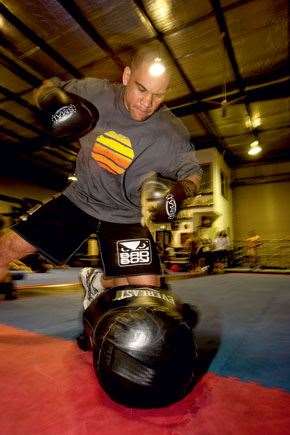 James Te Huna Punch Practice
James Te Huna Punch PracticeImages: Warren Clarke
The kick
“Not many kicks are used in the MMA. There used to be more in the past, but now most fighters use an opponent’s kick as an opportunity to take him down because he’s off-balance, he’s up on one leg. So kicking can be dangerous – but it can also be useful, particularly late in the round. Kicks can also be very dangerous against an opponent who doesn’t defend well, who’s very heavy-footed. So you always want to keep some good, fast kicks in your arsenal. My strongest kick is the left inside-leg kick. With that kick, from an orthodox stance, I’m kicking outwards, so I can keep my distance. Whereas to land a right-leg kick, I have to step in and kick inwards, so all my weight’s coming forward. That can open me up to a takedown.”
On the ground
“There’s huge number of jujitsu techniques that we don’t practise because they’re too risky with punches involved. You can get stuck in a ground-and-pound – you can get hurt. So there are just a few techniques that work in MMA, and they’re the ones we focus on. The basic rules are: if you’re on your back, keep your opponent close to you, or get him out of the punching range so he can’t hurt you. If you’re on top, then you want to create a gap so you can land punches, or pull him in tight for a submission. So it’s tricky – it goes both ways! My wrestling’s not too bad – I can survive. Except in my last fight... “(At UFC 127, Te Huna suffered an opening round submission defeat to Swede Alexander Gustafsson.)
Conditioning
“Because MMA rounds last five minutes, conditioning’s a big factor in the sport. It’s all about working your whole body, staying fast, using your speed, and maintaining explosive power. It’s very, very hard – it always breaks me down! But it’s just something you’ve got to do. Of course, sparring’s the number-one way of building your conditioning. You can’t beat sparring. But personally, I like to mix my conditioning work up. So I might do circuit exercises, where I’ll do, say, ten power cleans, then 20 push-ups, then 50 double-jumps, then a 100m sprint. Then I’ll repeat that circuit, non-stop, until five minutes is up. I also do interval sessions where I’ll go 30 seconds on, 30 seconds off, with an active rest. So I’ll do, say
30 seconds of hitting the heavy tyre with a hammer, then I’ll do 30 seconds of shadow-boxing, then I’ll do 30 seconds of flipping the tyre, then 30 seconds of skipping. Again, I’ll do that non-stop for five minutes. I find that’s really good for replicating a fight, where you exchange punches – boom-boom-boom – then you step away and circle for a while.”
Mind games
“The key with your mind is just to focus on your fight and keep a clear head. If any problems come your way – you’ve got toeither resolve them or brush them off. Family problems, recurring injuries – these things can get in your head and bring you down. They can turn a positive attitude into a negative one just like that. With my last fight at UFC 127, my father had a heart attack four weeks out. I’m really close with my dad, so I was going to the gym but thinking about him, instead of going home and resting, I was going to the hospital. Things like that can bring you down. So you’ve just got to stay positive, man. Any negative thoughts you’ve just got to leave them behind. Being in a positive environment, having a positive group of people around you – that’s the key. You know, I’ve trained with so many guys who are absolute animals in the gym, punish everyone. But then they have a fight and they crumble. They can’t deal with it. They don’t believe they’re at the right level. They break down in the middle of the fight. And that’s the worst thing that can happen to a fighter. You have to stay positive.”
The F word
“Fear used to figure in my mind before fights. I used to look at the other guy and go, ‘Oh man! He’s got a big set of muscles on him! He’s taller than me! I don’t want to fall on my face – my family’s coming here to watch me…’ I put pressure on myself. But I got over that after a few fights. I learnt how to deal with it. You just can’t worry about the other guy. If he’s got good hands on him, you think, yeah, but I’ve got a good take-down. If he’s got a long reach you think, yeah, but I’m good at getting inside. Things like that. You’ve just got to believe in yourself. There are some fights where I’ve really built up a hatred for the other guy, and I want to put him away as fast and as hard as I possibly can. Sometimes that works. But other times I’ve met my opponent previously – we’ve talked, we know each other’s game, we’re friends. So I’ve come out smiling before the fight.”
Seeing it
“About a month out from a fight, I’ll start visualising the day of the fight. I’ll go over everything: eating breakfast, watching a movie with my mates, going home, getting my gear ready… I go over all this in my head so that when it comes to the day there are no surprises – I’ve been over everything a thousand times. I visualise driving to the stadium, going backstage, getting my hands wrapped, warming up, waiting to get called out. Then I visualise myself walking out in front of that crowd, having tunnel vision on the guy I’m fighting. It’s like drilling your takedowns, or your punches – it’s drilling your mind so that when the day comes there’s nothing new,
nothing surprising.“
 James Te Huna
James Te HunaImages: Warren Clarke
Wear and tear
“I’ve had probably 50-odd dislocations of my right shoulder. In my first MMA fight, back in ’03, I threw my opponent on the ground, posted my arm, and it just popped out. I managed to get back to my feet, saw my shoulder and thought, what the fuck… He put me back on the ground and I had to tap out. Ever since then, it’s come out in training, in fights, when I’m sleeping. I had a big fight against a Japanese opponent, Takahiro Oba, and in the first minute of the fight, I knew I was going to finish this guy. But then I got in a position on the ground where I was trying to sweep him, and my shoulder came out again. The ref saw it was locked out, so he jumped in and called the doctor into the ring. The doctor didn’t know how to put it back in – he was talking to the ref, discussing whether or not to stop the fight. And while they were talking I ran over to my cornerman and he yanked on it and it fell back into place. I turned around, waving my arms, saying, ‘I’m ready! I’m ready, see?’ So the ref started the fight and the crowd was going off. It ended up going the full three rounds and I got the decision on him. Had to work bloody hard for that. Eventually, in 2007, I had to have surgery on the shoulder. I got the right surgeon, did the right rehab, took a year off – really looked after it. After that I won six fights in a row, five of them by stoppage. I guess it helps having two arms to fight with instead of one and a half!”
Showtime
“At UFC 110 in Sydney I was fighting a guy called Igor Pokrajac – he trains with the Croatian fighter Cro Cop. Before that fight I was positive – I’d done all my visualisation – but as soon as they pulled that curtain back and I walked out, I just got so distracted, man! I found myself looking at the crowd … I had nothing! It was so huge, you know? I remember walking up the steps to the cage, then I had a big blank spot. The next thing I remember is me on my hands and knees, looking at the canvas, and some bloke on my back trying to choke me. I thought, fuck, the fight’s already started! So that first punch must’ve hurt me. But I fought back … At the opening of the third round we came out, traded a wee bit, then he launched a head kick. I saw it coming but because I was gassing I only put my left arm up to block it – a flimsy block. And then I heard a noise that sounded like a wet stick breaking. I knew from then that I probably had a good minute to finish the fight otherwise I would’ve been in real trouble. So I got a takedown. He got to his feet. I slammed him again. Then I got him in the crucifix position, him on his back, me on top. I had a free shot at his face and I was punching him, one after the other, boom-boom-boom, but it was with the broken arm, so the punches weren’t too hard! Then I heard the referee say, ‘Protect yourself or I’m stopping the fight.’ And I knew I had him from there.”
‒ Aaron Scott
Related Articles

Garriock ready to put the boot into new role
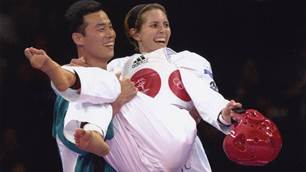
Sydney Olympic hero reminisces about her golden moment
